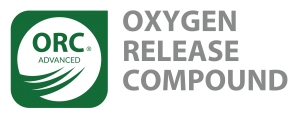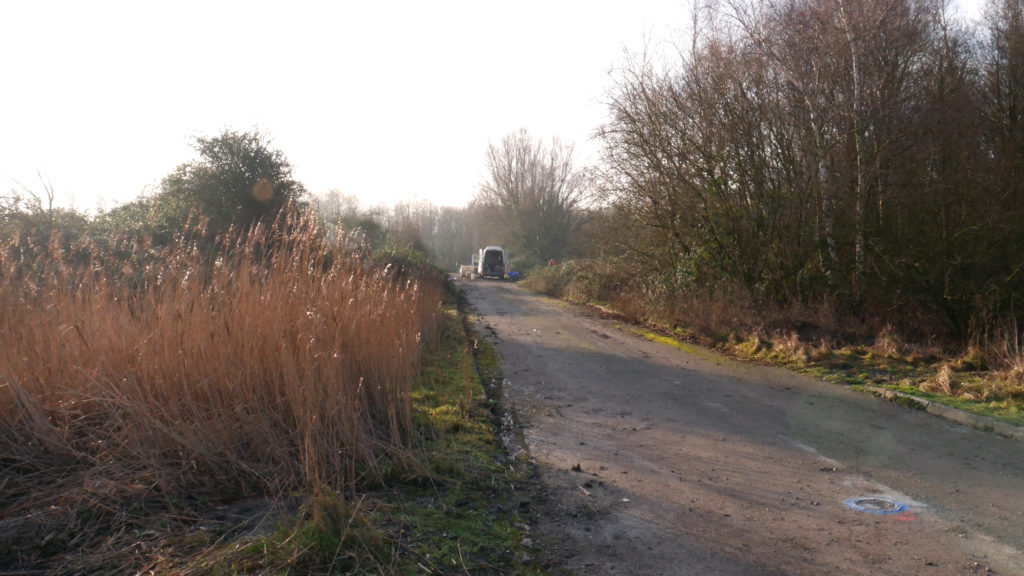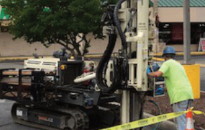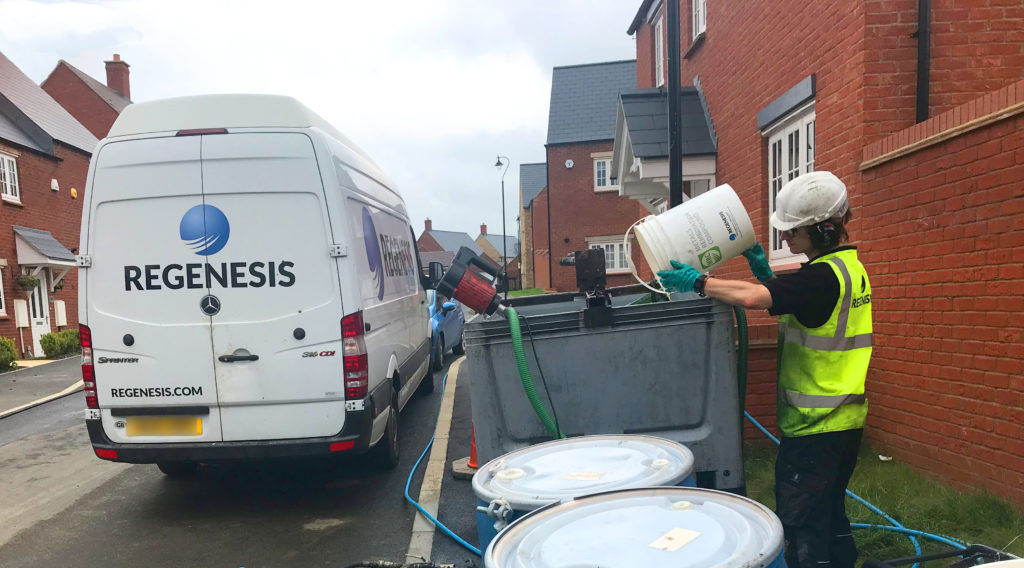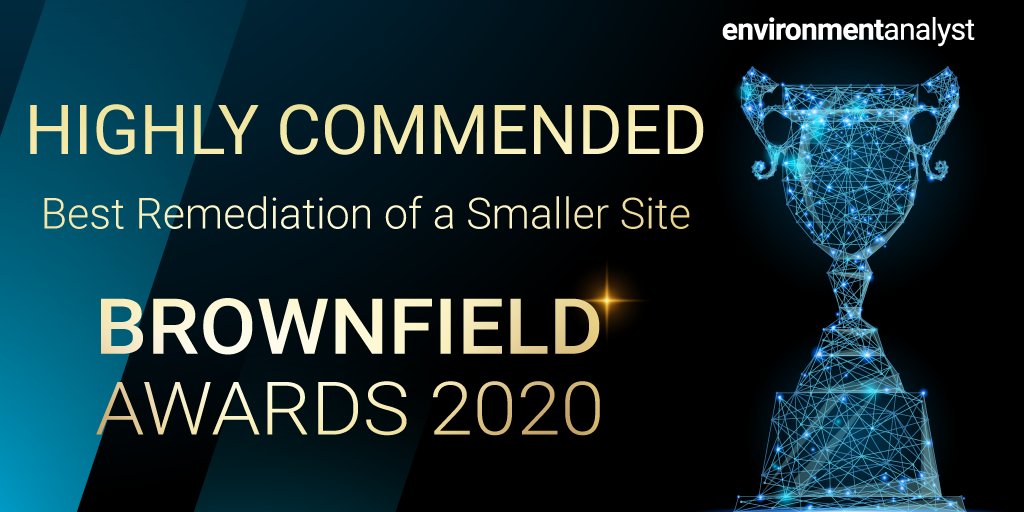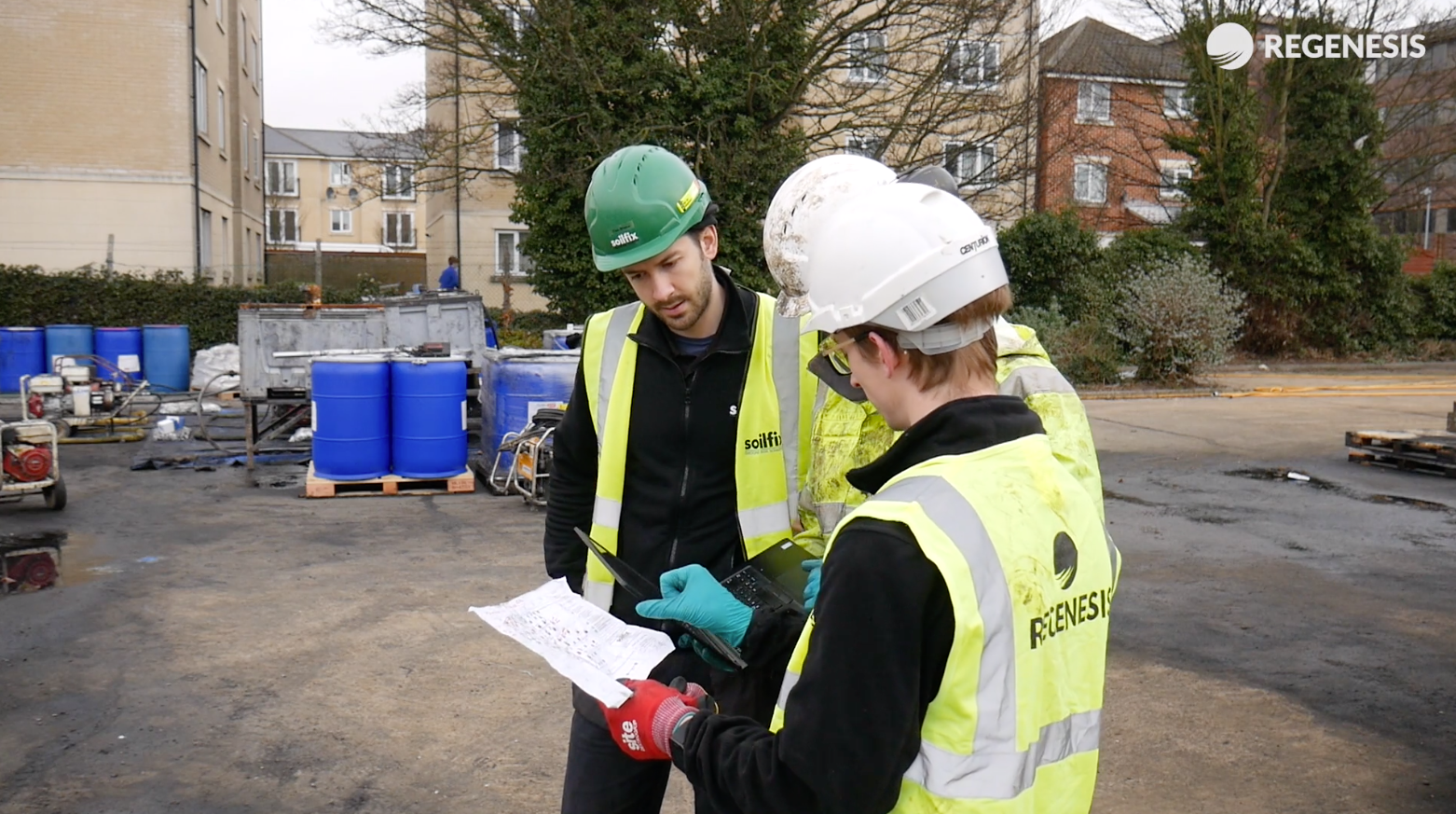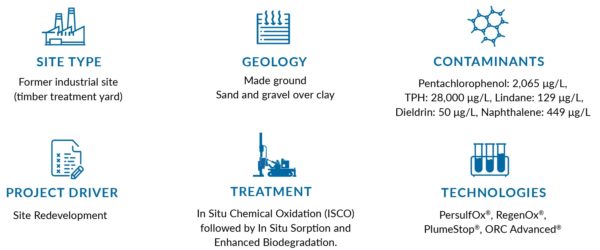First Application of PetroFix at Petrol Filling Station in Sweden
Integrated groundwater treatment strategy using RegenOx, ORC-Advanced and PetroFix yields a 98% reduction in groundwater contaminant
concentrations
Introduction

RGS Nordic was asked by Circle K to remediate groundwater contaminated with gasoline at an active Petrol Filling Station (PFS) in Nykvarn, Sweden. During the site investigation, petroleum hydrocarbon contamination was identified within the fill material around the underground storage tank (UST) farm.
RGS Nordic was required to deliver a remediation strategy that posed minimal disruption to the commercial operations of the PFS. The chosen remediation strategy combined targeted excavation, in situ chemical oxidation (ISCO), in situ sorption, and enhanced aerobic biodegradation using a range of complementary REGENESIS technologies: RegenOx®, ORC-Advanced® and PetroFix®.
Case Study Highlights
- The integrated remediation treatment strategy ensured that optimum treatment efficiency was maintained throughout the phases of works, resulting in:
- The amount of excavation and offsite disposal was minimised.
- All underground infrastructure remained in situ.
- All works were completed at an active petrol filling station with minimal disruption to the commercial operations of the facility.
- 12-month period monioring results show reductions of >98% of the gasoline range of petroleum hydrocarbon concentrations in the groundwater.
4m 32s reading time

Remediation Products Applied
Please click on the logos below for more product information.
In Situ Remediation of CHCs within a Bedrock Aquifer, Germany
Case study: High concentrations of chlorinated hydrocarbons (CHCs) were observed in a sandstone bedrock underneath a school in Bavaria, southwest Germany. Environmental Consultant Wood worked with REGENESIS to develop an in-situ groundwater remediation solution for the site.Read More
In situ treatment of MNT, DNT and TNT at former explosives factory
in situ remediation solution for groundwater contamination relating a former explosives factory, now redevelopment site. Goal: mass reduction of dissolved phase propellant contamination, a co-mingled TNT, DNT, MNT plume.Read More
Performance-Based Objectives Achieved at Scott AFB
This case study reviews the Corrective Action Plan (CAP) at Scott Air Force Base, a large military base located in Southwestern Illinois that was contaminated with petroleum impacted soil. One month following the application of PetroFix®, contaminant levels reached non-detect. Benzene continued to remain non-detect through March 2020 and the site was recommended for no further action. The final CAP Addendum proposed two rounds of groundwater treatment by injection at Former Tank 85 to reduce benzene concentrations below the groundwater remediation objectives. The first round of injections was completed in February through March 2018 and consisted of the use of REGENESIS’ RegenOx®, coupled with ORC Advanced® to stimulate aerobic bioremediation. The initial injection was successful in reducing most contaminants within the affected area. The second round of injections at the former UST was completed in March 2019 using REGENESIS’ PetroFix micron-scale remedial fluid.

Case study highlights:
- Impacted soil was caused by leaking underground piping and removal of two large UST’s
- Second round of direct push injections included PetroFix to treat lingering BTEX
- One month following application of PetroFix, BTEX levels were at non-detect and have continued to remain at that level for 5 sampling events
5m 25s reading time
NFA Status Achieved at Virginia Gas Station Site
This case study reviews a former retail fueling center in Virginia where Sovereign Consulting was hired to demolish the site and remove a 25,000 gallon underground storage tank (UST) which was also the source of the LNAPL contamination. Working with the Virginia Department of Environmental Quality (VADEQ) Sovereign conducted a Site Characterization Assessment and following monitoring was then retained by their client to demolish the fueling center and remove the 25,000-gallon gasoline UST and the associated fueling system which represented the source of the contamination.
Once the source of contamination (UST) and the free-product was addressed, Sovereign worked with REGENESIS to formulate and execute a groundwater remediation plan that used PetroFix. Unlike other groundwater treatment materials, PetroFix was utilized due to its dual function – it quickly removes hydrocarbons from the dissolved phase by absorbing them onto the activated micro-carbon particles and the electron acceptors promote hydrocarbon biodegradation in situ to encourage continued remediation. This combination resulted in a rapid decreases in contamination in weeks as opposed to months as determined through monitoring well groundwater sampling and the corresponding concentration curves for each chemical of concern.
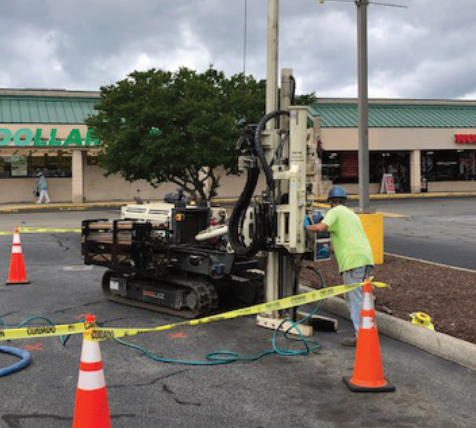
Case study highlights:
- PetroFix quickly reduced BTEX, Naphthalene, and THP-GRO Concentrations to reach site goals
- Pollution Complaint Case Closure granted by the VADEQ in less than one year post-application
- Single application of PetroFix addressed contaminants of concern to help site reach closure
5m 2s reading time
PlumeStop Arrests PCE in Fast Moving Aquifer
This case study reviews a former dry-cleaning site in Martinsville, Indiana that had a perchloroethylene (PCE) release which contaminated the community’s groundwater with concentrations in excess of 370 parts per billion (ppb). The sand and gravel aquifer created a challenging problem due to the high flow regime, with a groundwater velocity of approximately 1,560 ft/year and oxygenated geochemistry which had limited natural attenuation. After a thorough evaluation of possible technologies, environmental consulting firm Wilcox Environmental Engineering determined that PlumeStop® Liquid Activated Carbon™ in combination with HRC® and BDI Plus® could prevent the plume from migrating and would work in the well-oxygenated, sand and gravel lithology.
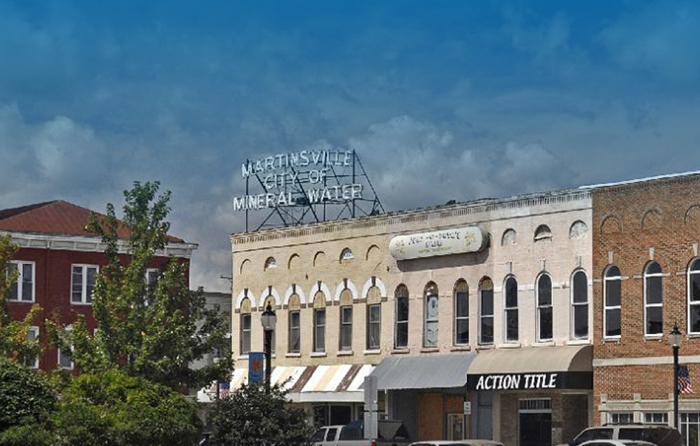
Case study highlights:
- PlumeStop effectively treated the plume in the well-oxygenated, sand and gravel lithology
- 99% reduction of PCE ~30 days after the application in key monitoring wells
- Demonstration of PRB leading to full-scale treatment in Spring 2020
6m 44s reading time
Treatment of Cr(VI) and CHC Groundwater Contamination under a Residential Development
In situ remediation of hexavalent chromium (VI) and chlorinated solvents using combined anaerobic biodegradation and immobilisation in Northampton, UK
Background

On the site of a former chrome plating works, construction and inhabitation had begun on a new residential development. Hexavalent chromium (Cr(VI)) and some chlorinated hydrocarbon compounds (CHCs) had been discovered in the groundwater beneath the development. It was determined by the environmental consultant that the Cr(VI) was driving a risk on the site. The housebuilder required rapid achievement of site targets in order to continue the development of the site.
Case Study Highlights
- REGENESIS provided an accurate and pragmatic design approach for the busy residential construction site
- Full-scale remediation was completed comprising a of a series of rows, totalling 78 injection points, to fit in between the residential properties and services
- A mixed plume of CHCs and Cr(VI) was treated concurrently using a combination of complementary substrates
- The works were completed rapidly with minimal disruption to the construction project and existing residents
- The use of barriers, targeting hotspots and pathways provided a cost-effective and efficient treatment of the plume
- Remediation Cost and Result Graph included
2m 40s reading time
Remediation Products Applied
A combination of ERD and in situ immobilisation using 3-D Microemulsion (3DME) and Metals Remediation Compound (MRC) has been used to primarily to treat the Cr(VI) contamination.
PFAS Contaminants Reduced to Non-Detect
This case study reviews a bulk storage facility located in the Middle East region that had released a mixed plume of petroleum hydrocarbons and Per and Polyfluoroalkyl substances (PFAS). PFAS constituents were effectively reduced to non-detect following the application of PlumeStop and have remained at these levels for twelve months post-application.Read More
Pesticides, VOCs and petroleum hydrocarbons remediated with a suite of in situ technologies
Shallow aquifer treatment using RegenOx, PersulfOx, ORC Advanced and PlumeStop at a former industrial site, UK
This project was Highly Commended in the Brownfield Awards 2020 in the category of ‘Best Remediation of a Smaller Site’.
Located in East Anglia, this industrial site had been occupied by a timber yard, incinerator, fuel storage tanks and a saw mill. These were later demolished and the site-use changed to light commerical and a car park for a FTSE 100 Company. It was decided that the site should be prepared for redevelopment and a due diligence site investigation was carried out by Ramboll to support lease surrender.
It was discovered that in a corner of the site, the soils and groundwater were impacted with a wide range of contaminants including petroleum hydrocarbons, volatile organic compounds (VOC’s) including BTEX, trimethylbenzene, pentachlorophenol and a mix of pesticides, including organochlorine pesticides (Dieldrin) and gamma-HCH (Lindane). Soilfix worked closely with Ramboll and REGENESIS to deliver a tailored multi-phase remediation solution for the site, including in situ remediation using a suite of REGENESIS’ remediation technologies.
REGENESIS services team carried out the groundwater remediation works on-site which included a combination of in situ chemical oxidation, sorption and enhanced biological degradation. Click the case study link to find out more, or watch the project video.
7m 3s reading time
“The project was a great success. Not only did we meet the betterment-based objectives that we agreed with the Client’s consultant Ramboll; for many of the contaminants we ended up meeting the stringent criteria that were originally derived by the risk assessment. This enabled the Client to surrender their lease on their programme. We felt this was largely down to the project team approach that we took with REGENESIS, from conception through to validation and completion of the project.”
Steve Jackson, Director, Soilfix
Case study highlights:
- Soilfix, Ramboll and REGENESIS worked together to develop a tailored multi-phase remediation solution.
- Integrated application of remediation products: RegenOx, PersulfOx, PlumeStop and ORC Advanced.
- Validation results show a rapid and sustained reduction in the concentration of all contaminants of concern (COCs).
- Remedial targets were achieved in time for lease surrender, with all stakeholders satisfied with the works completed.
Global Retailer Enters Into Elective Site Cleanup Agreement and Achieves NFA
This case study reviews the site of a global retailer based in Arkansas, where historic offsite dry cleaning operations caused tetrachloroethylene (PCE) contamination in the groundwater. A previous bioremediation attempt successfully remediated a majority of the site but one persistent well remained. After time passed with little change to the B-45 well, ESGI sought out a bioremediation strategy that would work quickly with long term success. ESGI partnered with REGENESIS to design a bioremediation plan that would apply PlumeStop®, Liquid activated Carbon, Hyrdogren Release Compound® (HRC) and Bio-Dechlor Inoculum® (BDI Plus) to eliminate the remaining contaminants of concern (COCs). After the applications of PlumeStop, HRC, and BDI Plus, all COCs were below the acceptable threshold levels, and as a result the site achieved No Further Action (NFA) in January of 2020.

Case study highlights:
- PlumeStop, HRC, and BDI Plus successfully remediated persistent PCE, VC, and Cis-1,2-DCE contamination.
- Environmental services firm ESGI and REGENESIS adapted the injection design according to the difficult site geology and weather conditions.
- After one round of injections, successful results led to the site achieving NFA.
6m 3s reading time

 Americas
Americas Europe
Europe Français
Français Deutsch
Deutsch Italiano
Italiano Español
Español

